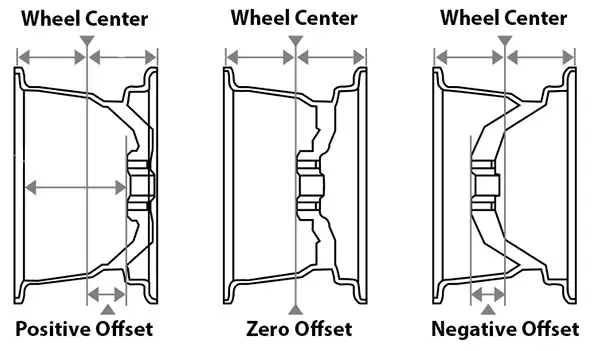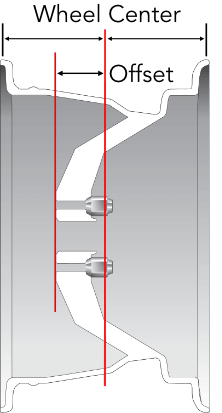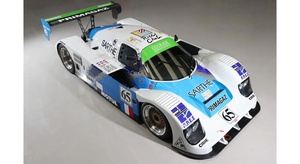
BradLTL
UltraDork
6/28/20 10:30 a.m.
I like to think I know my fair share about cars and whatnot. But an area that just completely escapes me is wheel sizes and fitting. I understand the basics of diameter, width and bolt pattern, but when we talk about offsets and backspacing I get lost.
Without using Tireracks website, how does one know what wheels fit? What happens when I change to a big brake kit? How much rubber can I put under the car until running a risk of rubbing?
Ugh...
I stick to offset, not backspacing. They tell you the same thing in a different way, the relation of the hub face to the width of the wheel.
Offset does so from the centerline of the wheel.
For BBKs, they generally have a cutout you can print, and place against the hub of the wheel to test fitment.
As for how much rubber, almost all the common platforms are already figured out, if not, lots of careful measurement inside the front and rear wheel wells.

Many aftermarket brake manufacturers will list the wheel size needed to fit. They'll say something like "requires 16 inch wheel, some 15 inch may fit."
If you're doing a parts-bin swap, just look to what wheel sizes were offered with that disc option.
I am currently (over the last three years) fabbing a size measurer-thingy. It is a center plate that bolts onto the brake with an arm and a piece of threaded rod. You can slide the rod up and down the arm to simulate tire diameter, and also thread the rod in and out to measure backspacing. Different lengths of threaded rod can simulate tire width.
bolt it on, spin it, turn the wheel, raise and lower the suspension, rinse, repeat. That (along with a healthy dose of googles and enthusiast forums) will get you a package that works. Sometimes it's as easy as "what's the widest tire that fits my Camaro," and 15 people will chime in with 245mm easy if you have this wheel, maybe 255mm if you have that wheel. If your question is more like "what's the widest tire I can fit in an Opel-bodied, Miata-chassis with E46 springs, mustang wheels, and F150 brakes," that's when you break out the measuring tool and figure it out for yourself.
Important to remember that Offset and Backspacing are measured a bit differently, but it is two ways of arriving at the same result.
Offset is a plus or minus from center. That means keeping the same offset but adding width means you increase backspacing (and front spacing by the same amount.
The way the difference between the two methods works is that wheel width is measured inside the lip where the tire bead rests. Backspacing is measured as total to the outside of the lip.
Since the lip might be 1/2" thick, you might see numbers that don't seem to add up, but they actually do.
On a 16x8" wheel with zero offset, that means that suggests 4" backspacing, but it will likely be closer to 4.5". This is because the width specification is measured inside the lip. A 16x8" wheel will actually be closer to a total of 9" wide, hence the 4.5" backspacing.
To further frustrate things, nearly all of the images and graphics about how to measure a wheel are grossly incorrect. Look at all of these WRONG images:



These all show wheel width as being the overall width to the outside of the lip which is entirely incorrect and further obscures understanding about how the measurements work. For demonstration purposes, some of those images are somewhat correct, but they all suggest that the wheel width is equal to the overall width and it is just not true.
This is a remedial drawing, but this is the important stuff below, and it is correct. A 16x8 wheel will actually be about 9" wide and 17" in diameter. The important thing is that the specification (in this case 16x8) is measured at the spot where the tire bead sits.

Will they fit is a handy, easy to use tool with an easy to understand visual representation comparing any wheel spec you chose to enter.

You can bump the offset around to even out backspace and change tire sizes all you like. Or you can just enter in your current wheel and the specs of what you are interested in to compare
Find someone (internet or reality) that runs a wheel in the style or at least the size you're looking for, and ask for the specs.
The FT86 community has a massive online thread that lists every conceivable size and configuration that fits the FR-S/BRZ/GT86. Wheels are listed by manufacturer with links to actual people's cars.
FWIW, this site https://www.wheel-size.com/ lists the ET numbers for a lot of factory vehicles.
Back spacing is an easy to do thing. Offset not so much.
Most wheels have the offset marked in in some way.


I borrowed a wheel from a friend, mounted a narrower tire on it (to better differentiate between tire/wheel interference, while still being able to visualize where the tire would be... This is a 15x9 et36 with a 195/50R15 RS4), and now have a good idea that it'll fit with a 3mm-5mm spacer for added clearance plus rolling/pulling the fenders.
A lot of use of www.willtheyfit.con and measuring known wheels ON the car already is how I came to the conclusion this wheel would be a very tight but potential fitment... And was lucky enough to have a friend with an extra wheel I could borrow for a few weekends.
I'll be going to a 15x9 ET35 + 225/45R15 up front, and a 195 or 205/50R15 on 15x7.5 ET35 out back (I currently run 15x7.5 ET42 with 10mm front spacer and 5mm rear spacer to make them effectively ET32 F and ET37 R so the rear isn't really a big change from what I have now).
Curtis73 (Forum Supporter) said:
Many aftermarket brake manufacturers will list the wheel size needed to fit. They'll say something like "requires 16 inch wheel, some 15 inch may fit."
This is why I mentioned using the template for a BBK. The wheel diameter is not the only determining factor. The barrel and spoke design can also affect whether or not a wheel will fit over a certain brake setup.

BradLTL
UltraDork
6/29/20 11:17 a.m.
Ok.. so conceptually I have a better understanding of what the measurements are, but I'm not sure I understand how to apply them really. So, let's do a word problem. :)
While a yes/no answer is good, I would actually like to know how to work this out.
- I have 2003 Mini Cooper S (R53) with 17x7 (offset: ?) running 205/45 R17
- I'm going to update the front brakes to a R56 (parts bin swap) components
- I would like to get a set of Sparco FF-1 17 17x8 wheels running 215/45 R17
So, questions:
- Adding an inch to the width, is that going to cause interference?
- Putting 215s on the wheel, will that cause interference?
- Could I put 225s or even 235s? (Not that I'm going to, but I don't understand how to know how to figure that out)
- Could I go down to 16" rims? Does that change the width the wheel? I can get 16x7 or 7.5s for the car, but could I then put a set of 245 Hoosiers on it?
For #1, look up the offset of both sets of wheels. If they have the same offset, the new wheel will stick outboard 1/2" more and inboard 1/2" more. Common clearance issues on a strut car would be the strut itself inboard and the fender outboard.
#2.. they are slightly taller in diameter, so possibly, but highly unlikely.
#3 yes, but if clearance @ #1 or #2 is tight you will want to be careful
#4 yes, provided it clears the brakes. No, it does not change the width or any other numbers.
This link that was posted above is probably the best place to start when trying to understand this. http://www.willtheyfit.com/
Look at all your current clearances, plug in the numbers for your current & new setup, and then see what you think.

Most important thing to know: the wheel is just he thing in the middle of the tire. Get the wheel that lets you run the tire you need. Too many people start with the wheel. Then get the bodywork you need to cover your tire. Again, this is usually done backwards.
Curtis73 (Forum Supporter) said:
I am currently (over the last three years) fabbing a size measurer-thingy. It is a center plate that bolts onto the brake with an arm and a piece of threaded rod. You can slide the rod up and down the arm to simulate tire diameter, and also thread the rod in and out to measure backspacing. Different lengths of threaded rod can simulate tire width.
We have one of these at FM :) Definitely a little challenging to use.
How to find what will fit your car: get a wheel/tire of any size. The car probably already has one. Remove the springs or do whatever you need to do to find full compression. Jam that wheel/tire into the wheelwell and start to measure clearance. Make sure to turn the front wheels to full lock both ways. Once you know how much room you have, you can calculate the maximum diameter and tire width. Note that actual tire width will vary depending on what wheel it's mounted on as well as what the actual tire is. It's more work than asking a forum but it's also where the actual information found on forums comes from if it's any good.


dps214
Reader
6/29/20 11:55 a.m.
As Keith and others have said, the only real way to figure out what will work for your specific fitment is to do some measurement and experimentation. I've recently been going through this with my cayman. I really don't want to deal with disassembling the suspension to figure out fender clearance the fully correct way as outlined by keith, so I've done things like sticking a gopro on the car pointed at the wheel/fender gap then driving over the biggest bumps I can find and doing an autocross run to see how much the suspension actually moves in practice. For inboard clearance, put a reference wheel/tire on the car, then do a lot of measuring to whatever is the limiting factor on inboard clearance, and do some math on what width/offset will clear, then test fit if at all possible. Like flatlander, I did a lot of measuring, decided on a fitment I was 98% sure would fit, then found some cheap wheels with the right specs to test out. Put them on the car and ended up with this, basically exactly as I measured:

Brake clearance gets a bit tricky because not all wheels have the same barrell profile or spoke backside design. So one wheel of a given size/offset may fit, but a different design of wheel with the same specs might not. If it's a common setup the internet can usually provide some amount of insight into what fits and what doesn't.

BradLTL said:
Ok.. so conceptually I have a better understanding of what the measurements are, but I'm not sure I understand how to apply them really. So, let's do a word problem. :)
While a yes/no answer is good, I would actually like to know how to work this out.
- I have 2003 Mini Cooper S (R53) with 17x7 (offset: ?) running 205/45 R17
- I'm going to update the front brakes to a R56 (parts bin swap) components
- I would like to get a set of Sparco FF-1 17 17x8 wheels running 215/45 R17
So, questions:
- Adding an inch to the width, is that going to cause interference?
- Putting 215s on the wheel, will that cause interference?
- Could I put 225s or even 235s? (Not that I'm going to, but I don't understand how to know how to figure that out)
- Could I go down to 16" rims? Does that change the width the wheel? I can get 16x7 or 7.5s for the car, but could I then put a set of 245 Hoosiers on it?
Honestly, I would contact the Mini Cooper equivalent of Flyin' Miata, and ask.
As ProDarwin pointed, #1/#2, are going to be dependent on the offset of the stock wheels and the offset of wheels you want to use.
#3 I'm betting with the correct offset, you could go 225. Again, seek out what others have already figured out for your platform.
#4 Are there 16" wheels that fit the R56 brakes on the R56? The aspect ratio of the Hoosiers and again, the offset of the wheel, will determine what will/won't fit.
Tire Rack shows 16x7 ET +37mm as fitting a 2010 R56 S. So it's probably safe to assume, you could run 16s with the upgraded brakes on your R53.

BradLTL
UltraDork
6/30/20 7:08 a.m.
Ok, the stock rims have an offset of +48, and the Sparcos have a +45. So, of I run the Sparcos and 225 tires that means:
- I'll gain 1/2 inch on the inside for the wheel
- I'll -3mm from that 1/2 inch for the offset
- I'll add 10mm from the width of the tire
Did I get that right?
(+ = Wider; - = skinnier)
You will have 1/2" - 3mm less clearance on the inboard side
You will have 1/2" + 3mm less clearance on the outboard side.

"a RPF1 fits the car in 16x8 and you can put R56 brakes under it with a 225 tyre on the car.
that should be plenty.
Look for that gray car on Mini torque under DOMO, Though its amazing to me how many people want to copy that car."
https://www.motoringalliance.com/threads/r53-widest-square-tire-setup.25178/

BradLTL
UltraDork
1/4/21 10:38 a.m.
Digging up my own old-ish thread. Wheels and tires are on the winter purchase list, and I don't want to make a $2000 mistake. So, for my 03 Mini S, I'm looking to get smaller and lighter... something like this:

So, looking at the will it fit site, I get this:


Generally this looks good. The one concern I have is that I'm going to update the front brakes to R56 calipers. Based on math, I think I just need to make sure that I have more than 16mm clearance on the inside of the rim. That right?

dps214
HalfDork
1/4/21 4:52 p.m.
If tire clearance is a concern at all I'd double check the specs on those tires. Hoosiers tend to run wide and are probably wider than the calculator shows.
I'm concerned about the wheel clearance around the brake caliper.
With the offset, I should actually have more room for the tire.
Earlier you expressed interest in a 17x8. If going down in diameter, why not a 15x8? Should be nearly the same price. 205 A7s will work great on an 8" wheel
In reply to ProDarwin :
You're correct. I was having trouble finding a good looking (very important for car performance... at least 5hp), light weight and affordable 15x8.
I have not purchased yet, but 15x8 with a 225 is definitely on the table. 949s are nice but hard to find.
I'm going to work on the poor man's BBK this month, I was window shopping and sizing... planning where to spend my stimulus.
I know Minis have a dozen rotor sizes available and I can't keep them all straight. R56S are the 280mm right?
I could not find a lot of info on the FF1s when searching myself. May fit, may not. Could just need some 3-5mm spacers.
I did find this when searching FWIW:
http://www.motoringunderground.com/forum/showthread.php?t=22254
And since I posted my theoretical tire/wheel combo before... Here was the end result.. 15x9 ET35 with 225/45R15 up front, 15x7.5 ET35 with 195/50R15 rear. 3mm spacers up front. Clearance is tight but no rubbing even on track.














































